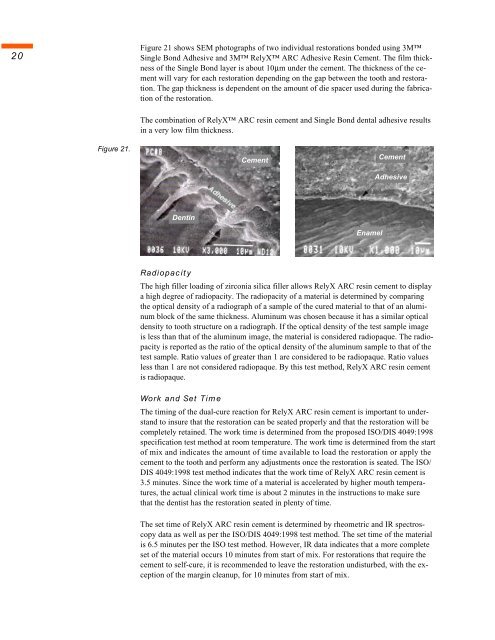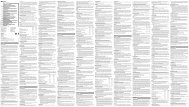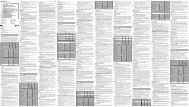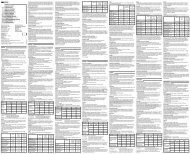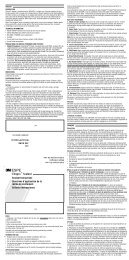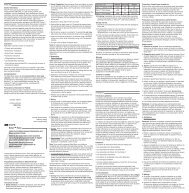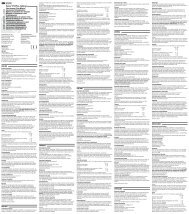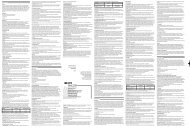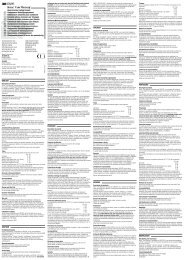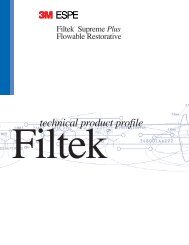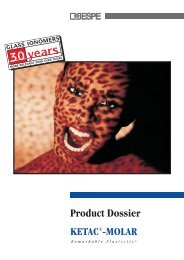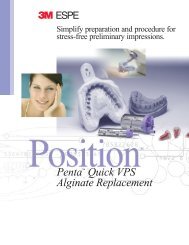RelyX⢠ARC Adhesive Resin Cement - Dale Dental
RelyX⢠ARC Adhesive Resin Cement - Dale Dental
RelyX⢠ARC Adhesive Resin Cement - Dale Dental
You also want an ePaper? Increase the reach of your titles
YUMPU automatically turns print PDFs into web optimized ePapers that Google loves.
20<br />
Figure 21 shows SEM photographs of two individual restorations bonded using 3M<br />
Single Bond <strong>Adhesive</strong> and 3M RelyX <strong>ARC</strong> <strong>Adhesive</strong> <strong>Resin</strong> <strong>Cement</strong>. The film thickness<br />
of the Single Bond layer is about 10µm under the cement. The thickness of the cement<br />
will vary for each restoration depending on the gap between the tooth and restoration.<br />
The gap thickness is dependent on the amount of die spacer used during the fabrication<br />
of the restoration.<br />
The combination of RelyX <strong>ARC</strong> resin cement and Single Bond dental adhesive results<br />
in a very low film thickness.<br />
Figure 21.<br />
<strong>Cement</strong><br />
<strong>Cement</strong><br />
<strong>Adhesive</strong><br />
Dentin<br />
Enamel<br />
Radiopacity<br />
The high filler loading of zirconia silica filler allows RelyX <strong>ARC</strong> resin cement to display<br />
a high degree of radiopacity. The radiopacity of a material is determined by comparing<br />
the optical density of a radiograph of a sample of the cured material to that of an aluminum<br />
block of the same thickness. Aluminum was chosen because it has a similar optical<br />
density to tooth structure on a radiograph. If the optical density of the test sample image<br />
is less than that of the aluminum image, the material is considered radiopaque. The radiopacity<br />
is reported as the ratio of the optical density of the aluminum sample to that of the<br />
test sample. Ratio values of greater than 1 are considered to be radiopaque. Ratio values<br />
less than 1 are not considered radiopaque. By this test method, RelyX <strong>ARC</strong> resin cement<br />
is radiopaque.<br />
Work and Set Time<br />
The timing of the dual-cure reaction for RelyX <strong>ARC</strong> resin cement is important to understand<br />
to insure that the restoration can be seated properly and that the restoration will be<br />
completely retained. The work time is determined from the proposed ISO/DIS 4049:1998<br />
specification test method at room temperature. The work time is determined from the start<br />
of mix and indicates the amount of time available to load the restoration or apply the<br />
cement to the tooth and perform any adjustments once the restoration is seated. The ISO/<br />
DIS 4049:1998 test method indicates that the work time of RelyX <strong>ARC</strong> resin cement is<br />
3.5 minutes. Since the work time of a material is accelerated by higher mouth temperatures,<br />
the actual clinical work time is about 2 minutes in the instructions to make sure<br />
that the dentist has the restoration seated in plenty of time.<br />
The set time of RelyX <strong>ARC</strong> resin cement is determined by rheometric and IR spectroscopy<br />
data as well as per the ISO/DIS 4049:1998 test method. The set time of the material<br />
is 6.5 minutes per the ISO test method. However, IR data indicates that a more complete<br />
set of the material occurs 10 minutes from start of mix. For restorations that require the<br />
cement to self-cure, it is recommended to leave the restoration undisturbed, with the exception<br />
of the margin cleanup, for 10 minutes from start of mix.


